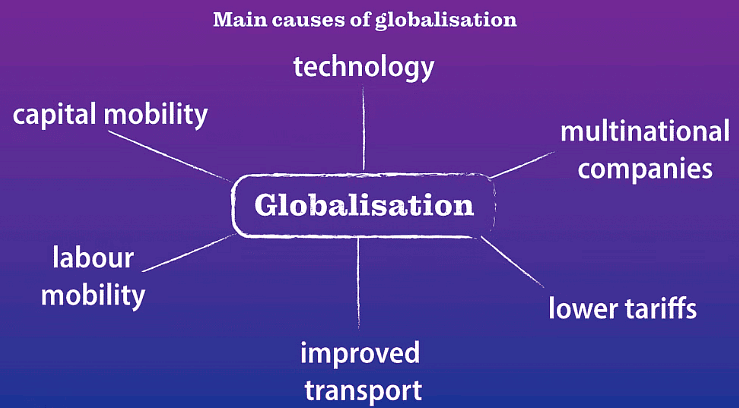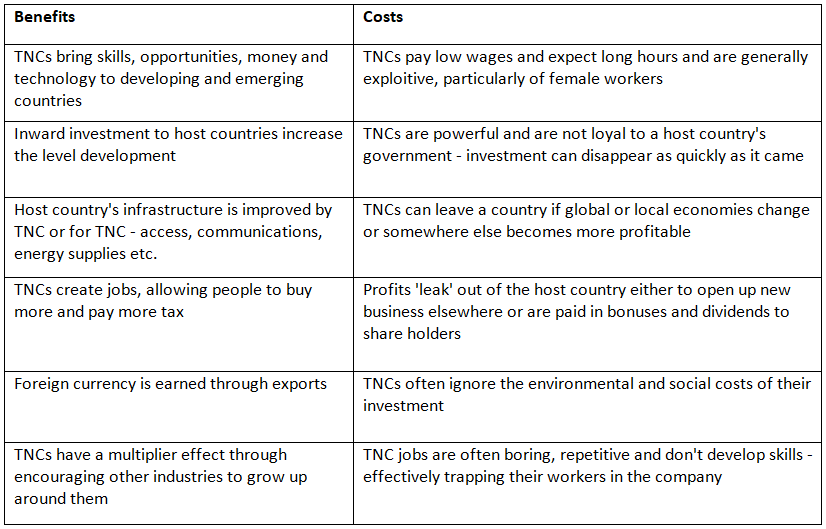Year 11 Exam > Year 11 Notes > Geography for GCSE/IGCSE > Globalisation
Globalisation | Geography for GCSE/IGCSE - Year 11 PDF Download
Globalisation
- Globalisation: The increasing interconnectedness of the world across various domains such as economics, culture, politics, trade, and tourism. This phenomenon also encompasses environmental aspects, evident in the effects of global warming.
- Historical Perspective: Although the term "globalisation" may seem modern, the essence of global trade and interaction has existed throughout history. Unlike the past, where trade could take extensive periods, advancements in transport and communication have led to instantaneous transactions - a concept known as time-space compression.
- Borderless World: Globalisation has blurred the political boundaries between nations, fostering interdependence. Powerful countries and multinational corporations now wield influence beyond their territories, contributing to global decision-making processes.
- Impact on Inequality: A notable consequence of globalisation is the exacerbation of global inequality. The disparities in wealth distribution and opportunities have widened due to the uneven effects of global integration.
- Technological Advancements: The progress in communication and transportation has been instrumental in shaping the current landscape of globalisation, transforming the world into a more interconnected and accessible entity - often referred to as a "shrinking world."
Time-Space Compression

Overview
- Faster: Refers to increased speeds in communication, travel, and financial transactions.
- Deeper: Involves connecting people's lives across distant locations.
- Longer: Indicates the stretching of connections between various places.
Significant Developments
- Large Transnational Corporations (TNCs): These are multinational companies that operate globally.
- Regional Economics and Trading Blocs: Groups of countries that form agreements to promote trade and cooperation.
- Modern Transport Networks: Advanced systems facilitating efficient movement of goods and people.
- Advancements in IT and Communication: Including the World Wide Web (WWW) and the internet, enhancing connectivity.

Global Economy and Network Flows
- Global Economy
- Almost every country in the world is interconnected in various ways.
- There are five primary network flows:
- Trade involves the exchange of raw materials, food goods, and services, facilitated by reduced trade barriers.
- Aid primarily focuses on economic assistance for education, health, infrastructure, and trade development in developing nations.
- Foreign investment occurs through direct or indirect means, such as companies like Shell oil investing in different regions.
- Labour is crucial for the global economy, with labor migration supporting markets with specialized or inexpensive workers.
- Information flow, involving fast data transfer and communication, is essential for global economic activities.
- The global production chain integrates these flows to create goods or commodities.
- Value is continuously added to products at each stage of the production process.
- Despite the vast distances and involvement of multiple countries, production remains cost-effective due to Economies of Scale.
- Economies of Scale refer to the cost reduction per item when operations are scaled up.
- Advancements in transportation, like large container ships, lead to reduced costs and faster movement of goods.
- Labor costs are lower in emerging economies due to cheaper labor and fewer regulatory constraints.
Question for GlobalisationTry yourself: What is globalisation?View Solution
Global investment
- Investment encompasses more than just economic contributions, extending to various forms of support.
Types of Investment
- Investment can manifest in various ways, such as in people, research, or products.
Foreign Investment
- Foreign investment involves individuals or firms from one country investing in another, benefiting both parties.
- For instance, call centers, like those in India, receive investments that lead to job creation and service provision for the investing country.
Moving Manufacturing Operations
- Shifting manufacturing activities from developed to developing nations, like China, helps in producing goods more efficiently.
- Investments in China result in the manufacturing of goods that are then exported back to the investor's country.
Investment in People
- Investments in individuals can target either leveraging cost-effective labor or tapping into specialized expertise.
- For instance, bringing a skilled surgeon from the USA to Australia signifies an investment in talent.
Research and Development Initiatives
- Investments in research and development, like those in the motor car industry for fuel-efficient vehicles, drive innovation and progress.
- Notable examples include Elon Musk's Tesla electric cars, showcasing advancements in sustainable transportation.
Aid as an Investment
- Following disasters or conflicts, aid serves as an investment in rebuilding and recovery.
- Aid can take the form of monetary assistance or direct provisions of goods and services to affected regions.
- However, challenges like corruption may hinder the effective allocation of aid resources.
Transnational Corporations (TNCs)
- Transnational Corporations function autonomously in foreign nations without a centralized management structure.
- TNCs and countries are pivotal components of the global economy, with governments and international organizations establishing regulations, although the primary investments come from TNCs.
- These corporations participate across various economic sectors and significantly influence the global economy, with the most prominent TNCs accounting for a substantial portion of global production.
- TNCs engage in direct investments in one country initially, later expanding to other regions, often in developing countries, to leverage cost-effective labor and incentives.
- Due to their primary focus on business expansion, TNCs may not align with the values of the host country, prioritizing profit and growth over local connections.
- The global dispersion of manufacturing operations, facilitated by TNCs, has been instrumental in the economic advancement of emerging nations like China, India, and Brazil.
Impacts of globalisation on people
- Globalisation has brought about advantages and disadvantages for various individuals, albeit at varying degrees.
- While some have reaped more benefits, the poorest members of society often find themselves at a disadvantage.
- An argument can be made that the absence of globalisation would have left the impoverished in a worse state, considering the employment opportunities and income derived from foreign investments by Transnational Corporations (TNCs).
- Nations like China, Brazil, and India have transitioned from developing to emerging economies due to globalisation, leading to direct benefits for their citizens.
- Generally, countries with higher levels of globalisation exhibit a narrower gender gap within their borders.
- Skilled laborers are in high demand and tend to profit more from globalisation compared to unskilled workers.
Benefits and Costs of Globalisation to People at Various Levels

Question for GlobalisationTry yourself: What is an example of foreign investment mentioned in the passage?View Solution
Impacts of globalisation on countries
- Transnational corporations (TNCs) play a crucial role in the process of globalization by connecting sources of raw materials to manufacturing centers, research and development hubs, and distributing products to worldwide markets.
- Through global marketing efforts, TNCs establish themselves as the premier brands to possess, enhancing their market presence and influence.
- Despite their global reach and branding power, TNCs primarily prioritize the interests of their shareholders, often seeking to maximize profits even if it comes at the expense of their workforce.
- Consequently, the actions of TNCs can have both positive and negative impacts on countries, influencing economic, social, and environmental factors.
Benefits and Cost of Globalisation to Countries at a Variety of Levels

Case Study - Nike
- Understand the global operations of a Transnational Corporation (TNC) like Nike.
- Identify the advantages and disadvantages for both the host country and the TNC's home country.
- For instance, analyze the impact of the USA-based company Nike.

- Keep the analysis straightforward by utilizing concrete facts and figures rather than generic information.
The document Globalisation | Geography for GCSE/IGCSE - Year 11 is a part of the Year 11 Course Geography for GCSE/IGCSE.
All you need of Year 11 at this link: Year 11
|
57 videos|70 docs|80 tests
|
FAQs on Globalisation - Geography for GCSE/IGCSE - Year 11
| 1. What is globalisation and how does it impact the global economy? |  |
Ans. Globalisation refers to the interconnectedness and interdependence of countries around the world in terms of trade, communication, and culture. It impacts the global economy by increasing the flow of goods, services, and capital across borders, leading to both benefits and challenges for countries involved.
| 2. How do transnational corporations (TNCs) contribute to globalisation? |  |
Ans. TNCs play a significant role in globalisation by operating in multiple countries, creating global supply chains, and influencing international trade and investment patterns. They often have a major impact on the economies of both developed and developing countries.
| 3. What are some of the impacts of globalisation on people? |  |
Ans. Globalisation can lead to job creation and economic growth, but it can also result in job losses, income inequality, and cultural homogenisation. People may benefit from access to a wider range of products and services but may also face challenges such as exploitation in the workforce.
| 4. How does globalisation affect countries differently? |  |
Ans. Globalisation can have varying impacts on countries depending on their level of development, resources, and economic policies. Developed countries may benefit from increased trade and investment, while developing countries may struggle with competition, environmental degradation, and social issues.
| 5. Can you provide an example of a transnational corporation (TNC) and its impact on globalisation? |  |
Ans. Nike is a well-known TNC that operates in multiple countries and has a global supply chain. Its production practices have raised concerns about labor conditions in developing countries, highlighting the complex social and economic impacts of globalisation.
Related Searches



















